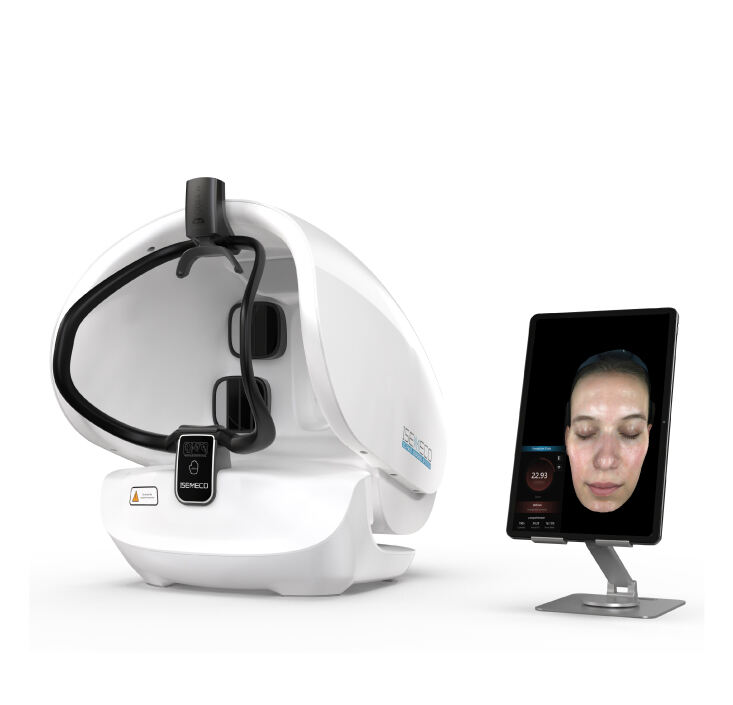
Anti-aging regimens—whether topical retinoids, micro-needling, or neuromodulators—require consistent monitoring to adjust dosages, timing, or modalities. MEICET’s MC10 Portable Skin Analyzer, designed for mobility without sacrificing accuracy, transforms follow-up care by bringing multi-spectral imaging to satellite clinics, outreach programs, or even partner facilities. Its compact design and wireless functionality make it an indispensable tool for tracking anti-aging progress beyond the main clinic, ensuring continuity in care regardless of location.
Tracking Anti-Aging Metrics On-the-Go
Anti-aging success hinges on measuring subtle changes: wrinkle depth, collagen density, and texture refinement. The MC10’s multi-spectral capabilities, including RGB, CPL, PPL, and UV modes, capture these metrics in minutes, providing clinicians with actionable data even outside the main facility:
- RGB imaging maps wrinkle morphology, distinguishing between fine lines (superficial, often linked to dryness) and deep creases (rooted in collagen loss). A patient using topical retinol can have follow-up scans that show reduced fine line visibility—confirmed by smoother texture patterns in RGB mode—indicating that the product is stimulating collagen turnover. For those combining retinol with micro-needling, RGB scans track how textural improvements progress, ensuring treatments are spaced to maximize collagen synthesis without over-irritation.
- CPL imaging assesses skin tightness by detecting changes in vascular tone. For patients undergoing radiofrequency (RF) treatments, CPL reveals increased blood flow in treated areas—an indicator of collagen remodeling as the body heals from controlled thermal injury. Consistently elevated blood flow over several sessions confirms that RF is stimulating the desired response, while stagnant or decreased flow may signal the need to adjust energy levels or treatment intervals.
- UV imaging monitors sun damage progression, even in patients using sunscreen. Subtle increases in UV fluorescence (from latent melanin activation) signal that sun protection may be inadequate, prompting reinforced education on broad-spectrum application or the addition of antioxidants like vitamin C to combat free radical damage. For patients with a history of sun exposure, UV scans also track how pigmented lesions respond to laser treatments, ensuring that fading is uniform and complete.
In a satellite clinic, a dermatologist can use the MC10 to follow up with a patient three months post-micro-needling: RGB scans show reduced wrinkle depth around the eyes, CPL confirms improved skin tightness in the cheeks (indicating collagen growth), and UV indicates stable sun damage (no new pigment formation). This data justifies continuing the treatment plan—with slight adjustments to the micro-needling depth—without requiring the patient to travel to the main clinic, reducing barriers to care.
Adapting Treatments with Real-Time Data
The MC10’s portability enables timely adjustments to anti-aging plans, ensuring interventions remain aligned with the skin’s evolving needs:
- A patient using a high-potency retinoid might develop mild peeling—a common side effect, but one that requires monitoring. A quick MC10 scan shows PPL indicating temporary barrier disruption (irregular light scattering) but no widespread inflammation. The clinician can recommend a lower concentration for two weeks, with a follow-up MC10 scan to check barrier recovery. This proactive adjustment prevents the peeling from progressing to more severe irritation, allowing the patient to continue retinol use long-term.
- For patients combining neuromodulators with collagen-stimulating therapies, the MC10 tracks how wrinkle relaxation (via RGB) interacts with texture improvements (via texture analysis). If scans show persistent lines around the mouth despite neuromodulator treatments, the clinician can add targeted collagen-stimulating therapies to support the treated area—addressing both dynamic and static concerns without over-treating either.
- Patients undergoing fractional laser resurfacing for photoaging benefit from MC10’s post-procedural monitoring. RGB scans track epithelialization (healing of the outer skin layer), while CPL assesses inflammation. If healing is delayed in certain areas (e.g., the forehead), the clinician can recommend localized moisturizing or soothing treatments to prevent infection, ensuring the entire face heals uniformly.
This agility ensures anti-aging regimens remain responsive to the skin’s changing needs, maximizing results while minimizing side effects. The MC10 eliminates the “wait-and-see” approach to follow-up, replacing it with data-driven adjustments that keep treatments on track.
Facilitating Collaborative Care
Anti-aging care often involves collaboration between dermatologists, aesthetic nurses, and even research teams—especially in clinical trials or multi-center studies. The MC10’s cloud integration ensures that scan data is accessible to all providers, regardless of location:
- A dermatologist at the main clinic can review MC10 scans from a satellite location, confirming that a patient’s retinol regimen is effective and approving a transition to a maintenance dose.
- Research teams studying the efficacy of a new anti-aging peptide can collect standardized MC10 data from multiple sites, ensuring consistency in how wrinkle depth and collagen density are measured.
- Aesthetic nurses performing follow-up treatments can reference MC10 scans to adjust neuromodulator dosage—e.g., increasing units in areas where RGB shows persistent dynamic wrinkles, or decreasing in zones where CPL indicates over-relaxation.
This collaboration ensures that anti-aging care is not fragmented by geography. Whether a patient is seen at the main clinic, a satellite office, or a partner facility, the MC10 provides a common dataset that keeps all providers aligned on goals, treatments, and progress.
The MC10 Portable Skin Analyzer redefines what’s possible in anti-aging follow-up, proving that mobility and precision can coexist. By bringing multi-spectral imaging to wherever patients are treated, it ensures that no detail is missed—from the subtle texture changes that signal collagen growth to the early signs of sun damage that require intervention. For clinicians committed to delivering consistent, high-quality anti-aging care, the MC10 is more than a tool—it’s a bridge that connects scattered points of care into a cohesive, effective journey.
 EN
EN
 AR
AR
 BG
BG
 HR
HR
 CS
CS
 DA
DA
 NL
NL
 FI
FI
 FR
FR
 DE
DE
 EL
EL
 HI
HI
 IT
IT
 JA
JA
 KO
KO
 NO
NO
 PL
PL
 PT
PT
 RO
RO
 RU
RU
 ES
ES
 SV
SV
 TL
TL
 IW
IW
 ID
ID
 SR
SR
 SK
SK
 SL
SL
 UK
UK
 VI
VI
 SQ
SQ
 HU
HU
 TH
TH
 TR
TR
 FA
FA
 AF
AF
 MS
MS
 UR
UR
 BN
BN
 LA
LA

